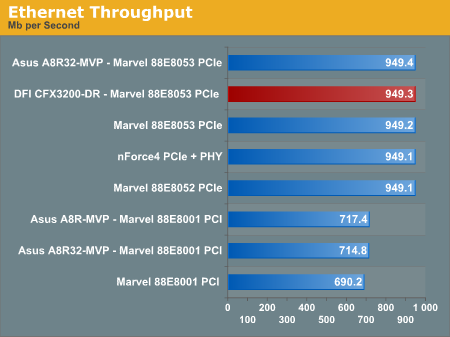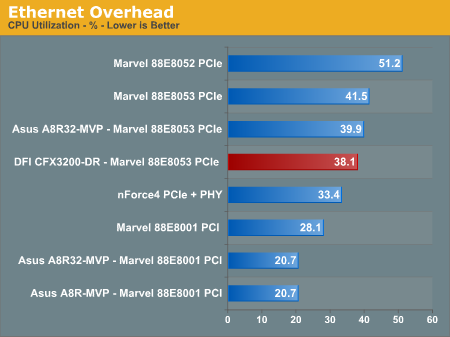DFI CFX3200-DR: ATI RD580 Tweak Attack
by Wesley Fink on May 8, 2006 12:05 AM EST- Posted in
- Motherboards
Network
The Windows 2000 Driver Development Kit (DDK) includes a useful LAN testing utility called NTttcp. We used the NTttcp tool to test Ethernet throughput and the CPU utilization of the various Ethernet controllers used on the AMD motherboards.We set up one machine as the server; in this case, an Intel box with an Intel CSA Gigabit LAN connection. Intel CSA has a reputation for providing fast throughput and this seemed a reasonable choice to serve our Gigabit LAN clients. At the server side, we used the following Command Line as suggested by the VIA whitepaper on LAN testing:
Ntttcps -m 4,0,‹client IP› -a 4 -l 256000 -n 30000
On the client side (the motherboard under test), we used the following Command Line:Ntttcpr -m 4,0,‹server IP› -a 4 -l 256000 -n 30000
At the conclusion of the test, we captured the throughput and CPU utilization figures from the client screen.

As you can clearly see the PCIe Gigabit LAN on the DFI is capable of about 35% faster speed than the performance we have measured with PCI Gigabit LAN used on some competing motherboards. DFI provides a pair of Marvell PCIe Gigabit controllers which should satisfy most end users. All of the on-board PCIe Ethernet controllers seem to exhibit high CPU utilization, but you should keep in mind that the CPU usage we measure is an extremely artificial number which measures the worst case of a continuous 1Gb transmission. With broad-band connections needing less than 100Mb Ethernet, the real-world CPU usage will be much lower than these test results.
USB and Firewire Performance
USB has been a problem area for the ATI SB450 chipset, but it has not been a major issue with the ULi M1575 Southbridge. To test performance of USB and Firewire on the DFI CFX3200-DR we ran our standard USB throughput test using an external USB hard drive. For Firewire tests an external Firewire 400 or 800 hard disk is used for testing. Our test method uses a RAM disk as our "server" since memory removes almost all overhead from the serving end. We also turn off disk caching on the USB and Firewire side by setting up the drives for "quick disconnect". Our results are then consistent over many test runs.We use just 1GB of fast 2-2-2 system memory, set up as a 450MB RAM disk and 550MB of system memory. Our stock file is the SPECviewPerf 8.01 install file which is 432,533,504 bytes (412.4961MB). After copying this file to our RAM disk, we measure the time for writing from the RAM disk to our external USB 2.0 or Firewire 400 or Firewire 800 drive using a Windows timing program written for AnandTech by Jason Clark. The copy times in seconds are then converted into Megabits per second (Mb) to provide a convenient means of comparing throughput. Higher Rates therefore mean better performance. Blue bars represent USB 2.0 performance, while green bars represent Firewire.

The DFI CFX3200-DR performed virtually the same in USB tests as we have measured in other recent tests of the ULi M1575. While USB performance is a bit slower than NVIDIA, it is definitely competitive with the NVIDIA results, with throughput about double the ATI SB450. This is a big improvement and the reason ASUS, ECS, MSI, Abit, and DFI are using ULi M1575 instead. This will likely change with the introduction of the updated ATI SB600, which is expected with the launch of ATI chipset motherboards for AM2.
DFI chose the excellent VIA VT6307 to power the IEEE1394 ports on the CFX3200-DR. The VIA has been tested as fastest Firewire 400 in past results - running neck and neck with the Agere Firewire chip. Performance is where we would expect for the VIA Firewire chip.










25 Comments
View All Comments
rqle - Monday, May 8, 2006 - link
"...breathlessly waiting for DFI's AM2 and Conroe motherboards."Great board, but not sure where this new mainboard will fit in since AM2 is coming, many can opt for the nforce expert if they need a board before AM2.
hoping AM2 version is in the works and will be release soon as well.
electronox - Monday, May 8, 2006 - link
*sigh*as far as gaming benchmarks go, what we really need to learn to do is to focus on the lowest framerates rather than the highest framerates (or even the average framerate). fink, anand, and co., you guys offer a progressive tech-journalism and no doubt have thought about what FPS performance really means.
in its most important application, FPS performance means the ability to convey a smooth, fluid visual experience without noticeable dips or jerks in motion. sadly, with the way things are marketed now, the overall fluidity of gaming is sacrificed to reach those peak framerates we all obsess about in our benchmarking suites.
as a long time gamer and enthusiast-sector consumer, i wish such high profile websites as yours would pay more attention to the worst parts of FPS gaming - the parts of the game where the intensity of in-game content is notched up, but often our video settings must be turned down in order to prevent epileptic siezures. such media attention might, in turn, lead industry developers to optimize their drivers for this exceedingly common problem which, in my opinon, is just as easily quantifiable and ever bit as important as average FPS performance.
my thoughts, electronox.
Dfere - Monday, May 8, 2006 - link
I have to agree. I make good money, but I no longer have the time to play with bleeding edge components and do modding. I know this is an enthusiast site, but at least for me , and I think a large amount of readers, an analysis of the max you might get out of a bleeding edge system is not all the value your site brings. A lot of posts by the readers show they have mid range systems. Thus I can only agree that an analysis of the FPS "issues" described above with a mid range system would help readers identify what would best go with their current system, not just a top of the line upgrade. I know your testing tries to determine , for example, CPU limits or GPU limits...... but it really only does so on bleeding edge systems..... and these comments were already mirrored in the latest AGP vid card releases......(why compare a new AGP card with new processor when most AGP owners have 754 systems.... etc)JarredWalton - Monday, May 8, 2006 - link
I think it all depends on what game you're talking about, and how the impact is felt in the fluidity of the FPS score. These days, the vast majority of first-person shooters have a pretty consistent FPS, at least in normal gaming. In benchmarks, you're often stressing the games in a somewhat unrealistic sense -- playing back a demo at three or four times the speed at which it was recorded. Why does that matter? Well, depending on the game engine, loading of data can occur in the background without actually slowing performance down much, if at all. In a time demo, you don't generally get that capability, since everything moves much faster.There are several other difficulties with providing minimum frame rates. Many games don't report instantaneous frames per second and only provide you with the average score. (Doom 3, Quake 4, Call of Duty 2, Half-Life 2, Day of Defeat: Source all generate scores automatically, but don't provide minimum and maximum frame rates.) If we notice inconsistent frame rates, we do generally comment on the fact. About the only game where I still notice inconsistent frame rates is Battlefield 2 with only 1GB of RAM -- at least on a system of this performance level. (I suppose I should throw in Oblivion as well.)
Sure, we could use tools like FRAPS together more detailed information, but given that there's a limited amount of time to get reviews done, would you rather have fewer games with more detailed stats, or more games with average frame rates? Realistically, we can't do both on every single article. Our motherboard reviews try to stay consistent within motherboards, our processor reviews do the same within CPU articles, and the same goes with graphics cards and other areas. If we have an article where we look at results from one specific game, we will often use that to establish a baseline metric for performance, and readers that are interested in knowing more about the benchmark can refer back to that game article.
Average frame rates are not the be-all, end-all of performance. However, neither are they useless or meaningless. we run into similar problems if we report minimum frame rates -- did the minimum frame rate occur once, twice, frequently? As long as people understand that average frame rates are an abstraction representing several layers of performance, than they can glean meaning from the results. You almost never get higher average frame rates with lower minimum frame rates, or conversely lower average frame rates with higher minimum frame rates -- not in a single game. In the vast majority of benchmarks, an increase in average frame rate of 10 FPS usually means that minimum frame rates have gone up as well -- maybe not 10 FPS, but probably 7 or 8 FPS at least.
In the end, without turning every article into a treatise on statistics, not to mention drastically increasing the complexity of our graphs, it's generally better to stick with average frame rates. Individual articles may look at minimum and maximum frame rates as well, but doing that for every single article that uses a benchmark rapidly consumes all of our time. Are we being lazy, or merely efficient? I'd like to think it's the latter. :-)
Regards,
Jarred Walton
Hardware Editor
AnandTech.com
OvErHeAtInG - Monday, May 8, 2006 - link
Good answer :) Also I think that minimum framerates (while very important in gameplay) are much more impacted by the videocard used. With a motherboard review, we're much more concerned with overall performance, which is exactly what you gave us with the avg. framerate numbers...